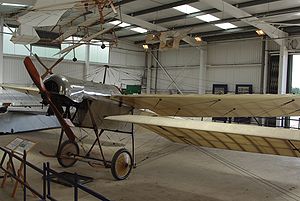Blackburn Type D Video - From Shuttleworth Collection
|
|
Blackburn Type D
Type D

Picture - The Type D, the oldest British flying aircraft, of the Shuttleworth Collection at Old Warden
Role: sports
National origin: United Kingdom
Manufacturer: Blackburn Aeroplane Co
Designed by: Robert Blackburn
First flight: late 1912
Status: still active
Number built: 1
The Blackburn Type D, sometimes known as the Single Seat Monoplane, was built by Robert Blackburn at Leeds in 1912. It was a single-engine mid-wing monoplane. Restored shortly after the Second World War, it remains part of the Shuttleworth Collection and is the oldest British flying aeroplane.
Development
The Type D was built for Cyril Foggin in 1912, a wooden, fabric-covered single-seat monoplane powered by a 50 hp (40 kW) Gnome rotary engine.
The Type D inherited some features from the earlier Mercury: it too had thin wings of constant chord with square tips of about the same span as the later Mercuries and used wing warping rather than ailerons. The wing was wire braced from above via a kingpost and below via the undercarriage and was built up around machined I-section ash spars. The Type D also had the triangular cross-section fuselage seen on several of Blackburn's aircraft from the Second Monoplane onward.
It was a neater-looking machine with a shorter fuselage, cowled engine, simplified undercarriage and heavily-revised empennage. The fuselage had rounded upper decking and aluminium covering at the front. Blackburn had persisted with the Second Monoplane's Antoinette-style fin and tailplane through subsequent aircraft, but the Type D's tailplane had a much less steeply swept leading edge (though still 60°) than its predecessors and carried a divided elevator. The fin likewise was less swept though still long and now carried a single rudder rather than the characteristic triangular pair used before. The undercarriage used a pair of wheels, compared with four on the Mercury, using two struts per side terminating on the skids and joined by the axle and a higher transverse strut. For the first time, Blackburn fitted a rudder bar in preference to his "triple steering column".
The aircraft first flew late in 1912. Some modifications followed in time: the engine cowling was extended into a semicircular shape to discourage the discharge of smoke and hot oil from the rotary into the cockpit; the wing tips were slightly rounded; and the crook-shaped skids were replaced by ones of hockey stick form.
Operational history
Harold Blackburn used the Type D for a series of demonstration flights from Lofthouse Park, situated between Leeds and Wakefield, from March to May 1913. He also flew to neighbouring towns: to Stamford, dropping leaflets; to Harrogate, where he landed; and on three successive days in late July to York, carrying bundles of the Leeds-printed Yorkshire Post. Foggin sold the aircraft on to Montague Glew, who crashed it in 1914 on the family farm at Wittering, where the remains lay untouched until discovered by Richard Ormonde Shuttleworth in 1938. After the War, the machine was restored by Shuttleworth's engineers. Almost all of the restored aircraft was original apart from the main wing spars, engine cowling, some minor wooden pieces and of course the fabric. The original Gnome was also discovered, though the restored aircraft used a slightly newer (1916) Gnome. The restored Type D flew on 17 September 1947, and still flies on quiet days with the Shuttleworth Collection, Britain's oldest active aircraft.
Specifications
Data from Jackson 1968, p. 80
General characteristics
Crew: 1
Length: 26 ft 3 in (8.00 m)
Wingspan: 32 ft 1 in (9.78 m)
Height: 8 ft 9 in (2.67 m)
Wing area: 236 ft² (21.9 m²)
Empty weight: 550 lb (250 kg)
Gross weight: 980 lb (446 kg)
Powerplant: 1 x— Gnome et Rhx´ne 7 cylinder rotary, 50 hp (37 kW)
Performance
Maximum speed: 60 mph (97 km/h)
Endurance: 2.5 - 3 hours
Service ceiling: more than 4,000 ft (1,200 m)
Jackson, A.J. (1968). Blackburn Aircraft since 1909. London: Putnam Publishing. ISBN 0 370 00053 6
"British Notes of the Week -Blackburn week.". Flight (12 April 1913): p.419. http://www.flightglobal.com/pdfarchive/view/1913/1913%20-%200413.html.
Blackburn Type D Pictures and Blackburn Type D for Sale.
Living Warbirds: The best warbirds DVD series.
Source: WikiPedia